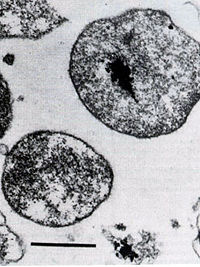Thermoplasma acidophilum
Jump to navigation
Jump to search
For the course duration, the article is closed to outside editing. Of course you can always leave comments on the discussion page. The anticipated date of course completion is May 21, 2009. One month after that date at the latest, this notice shall be removed. Besides, many other Citizendium articles welcome your collaboration! |
| "Thermoplasma Acidophilum" | ||||||||||||||
|---|---|---|---|---|---|---|---|---|---|---|---|---|---|---|
 | ||||||||||||||
| Scientific classification | ||||||||||||||
| ||||||||||||||
| Binomial name | ||||||||||||||
| "Thermoplasma Acidophilum" |
Description and significance
T.Acidophilum is a gram negative bacterium that varies from a spherical to filamentous structure. They can survive harsh conditions such as extremely low pH levels (0.5-4), and high temperatures (33-67°C).Like most extremophiles researchers have placed their emphasis on the proteins these microbes have, and their ability to survive high temperatures and low pH’s without denaturation occurring.
Genome structure
The genome of Thermoplasma is extremely small, and may very well be the smallest of all free-living bacteria. The genome size of Thermoplasma is about 109 Daltons.